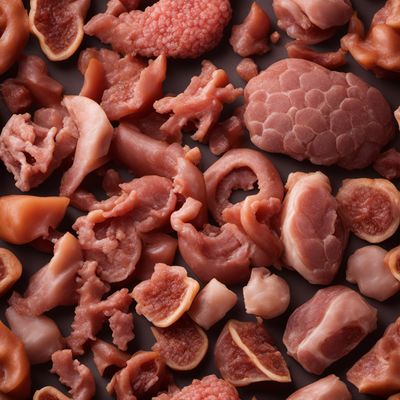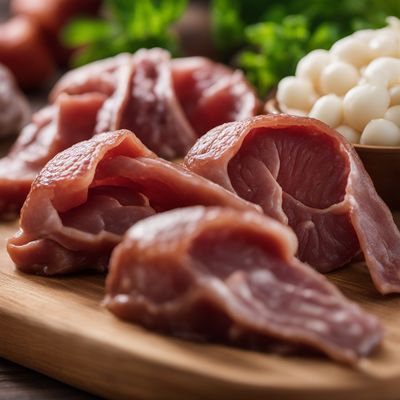
Ingredient
Deer edible offal, non-muscle, other than liver and kidney
The Hidden Gems of Deer: Exploring Non-Muscle Edible Offal
Deer edible offal, non-muscle, other than liver and kidney, encompasses a range of organs such as the heart, lungs, spleen, and more. With a tender yet slightly chewy texture, these offal cuts are rich in flavor and have a distinct gamey taste. The appearance varies depending on the specific organ, but they generally have a reddish-brown color and a unique marbled pattern. When cooked, the offal becomes tender and develops a rich, earthy aroma.
Origins and history
The consumption of deer offal has a long history, deeply rooted in various cultures around the world. In many traditional hunting societies, no part of the animal goes to waste, and offal has been valued for its nutritional benefits and unique taste. From Native American tribes to European cuisines, deer offal has been utilized in a variety of dishes, including stews, sausages, and pâtés.
Nutritional information
Deer edible offal, non-muscle, other than liver and kidney, is a nutrient-dense ingredient, providing essential vitamins and minerals such as iron, zinc, and vitamin B12. It is also relatively low in calories, making it a healthy choice for those seeking a lean protein source.
How to select
When selecting deer edible offal, non-muscle, other than liver and kidney, look for cuts that are fresh, firm, and free from any unpleasant odor. The offal should have a vibrant color and appear moist but not slimy. If purchasing from a butcher or specialty store, ensure that the offal comes from a reputable source and has been properly handled and stored.
Storage recommendations
To maintain the freshness and quality of deer edible offal, non-muscle, other than liver and kidney, it is best to store it in the refrigerator. Place the offal in an airtight container or wrap it tightly in plastic wrap to prevent any odors from permeating. Use the offal within a few days of purchase for optimal flavor and texture.
How to produce
Deer edible offal, non-muscle, other than liver and kidney, is typically obtained through hunting or sourced from specialty suppliers. It is not commonly produced by amateurs.
Preparation tips
Before cooking deer edible offal, non-muscle, other than liver and kidney, it is essential to thoroughly clean and trim any excess fat or connective tissue. Soaking the offal in milk or buttermilk for a few hours can help remove any gamey flavors. The offal can be grilled, pan-fried, or braised to enhance its tenderness and flavor. It pairs well with aromatic herbs and spices, and can be incorporated into stews, stir-fries, or even used as a filling for savory pies.
Substitutions
If deer edible offal, non-muscle, other than liver and kidney, is not available, you can substitute it with other game offal such as venison heart or lung, or even explore offal from other animals like beef or lamb.
Culinary uses
Deer edible offal, non-muscle, other than liver and kidney, is commonly used in various cuisines around the world. It can be added to hearty stews, sautéed with onions and garlic for a flavorful side dish, or incorporated into pâtés and terrines. The offal can also be used to make rich stocks and broths, adding depth and complexity to soups and sauces.
Availability
Deer edible offal, non-muscle, other than liver and kidney, is commonly available in regions where deer hunting is prevalent, such as North America, Europe, and parts of Asia.
More ingredients from this category

Goat edible offal, non-muscle, other than liver and kidney
The Hidden Gems of Goat: Exploring the Delicacies of Edible Offal

Rabbit edible offal, non-muscle, other than liver and kidney
Unveiling the Hidden Gems: Exploring the Versatile Rabbit Edible Offal

Wild boar edible offal, non-muscle, other than liver and kidney
Savory Treasures from the Wild

Camel edible offal, non-muscle, other than liver and kidney
Unveiling the Hidden Gems: Exploring the Exquisite Camel Edible Offal

Pig edible offal, non-muscle, other than liver and kidney
Beyond the Ordinary: Exploring the Versatility of Pig Edible Offal

Bovine edible offal, non-muscle, other than liver and kidney
The Hidden Gems of Bovine Offal

Equine edible offal, non-muscle, other than liver and kidney
Exploring the Hidden Gems of Equine Edible Offal

Sheep edible offal, non-muscle, other than liver and kidney
Exploring the Delicacies of Sheep Edible Offal